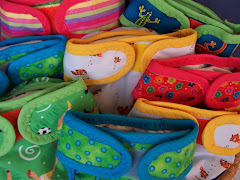 Up until now I've made my pads with a top layer of microfleece or suedecloth (except for pantyliners). They're fabrics that you can't find in Italy (or at least I've never found them there nor have I ever heard of anyone else managing to) but they're great for cloth menstrual pads and diapers. They are wicking materials, meaning they pull whatever liquid that gets on them down into the absorbent layers below, leaving the the top surface much drier. It's really incredible to see how much a pad (or diaper) can get wet without feeling wet.
Up until now I've made my pads with a top layer of microfleece or suedecloth (except for pantyliners). They're fabrics that you can't find in Italy (or at least I've never found them there nor have I ever heard of anyone else managing to) but they're great for cloth menstrual pads and diapers. They are wicking materials, meaning they pull whatever liquid that gets on them down into the absorbent layers below, leaving the the top surface much drier. It's really incredible to see how much a pad (or diaper) can get wet without feeling wet.But quite often people aren't totally convinced because these materials are synthetic. In theory, fleece is made at least partly with recycled plastic bottles, so it's a little more ecological in this sense. But most people who use cloth products don't want to use synthetic things if at all possible. Their biggest worry is that they're imagining jackets and other things made with thick fleece. Microfleece is a totally different product. It's very thin (and suedecloth even more so) and really soft. It doesn't irritate the skin at all, nor does it make you feel too hot in the summer. Actually, disposable pads are much more irritating first because they're full of chemicals (read here for more on that) and, being made of plastic, they don't let the skin breathe and it can feel quite sweaty "down there."
But I decided to see for myself and try some pads without these wicking fabrics. After all, lots of pad makers don't use these special fabrics, including most of them at Cloth Pad Shop, where I am also a seller. So I made three new pads to try out personally. They are, from left to right, with cotton flannel, regular cotton and bamboo velour. And I found that they do absorb quite well and the bamboo velour one is super soft and makes you feel really spoiled. The velour is also organic and naturally anti-bacterial. But when these types of pads get wet, they stay damp on the surface. I still prefer pads with microfleece and suedecloth, but I've decided to start producing some pads without those materials for those who still really prefer not to use them.






No comments:
Post a Comment